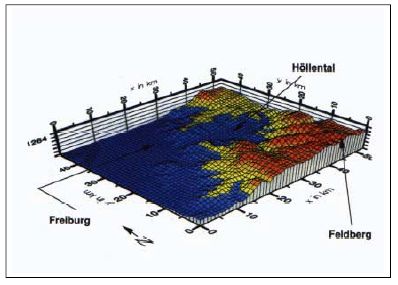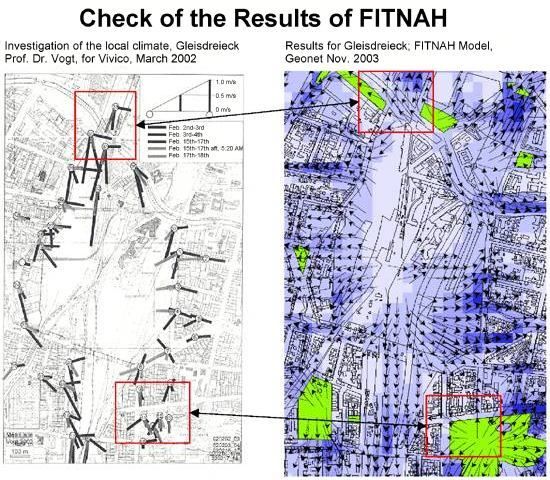One important factor in the creation and formation of an urban climate are the soil and surface characteristics, which have been changed in the urban area in relation to the surrounding countryside. The result is urban overheating and also the local urban wind circulation. Wind and temperature as well as quanta derived from them are the dominant factors affecting the assessment of urban climate from the aspects of human bio-meteorology and air quality.
The investigation and recording of the urban climate can be carried out with the help of various methods. These include field measurements, long-range ascertainment methods, wind tunnel studies, and the application of numerical simulation models. Hitherto, the procedures of field measurement and long-range ascertainment have been used as a matter of priority for the recording of urban climatic phenomena for the Environmental Atlas of the Senate Department of Urban Development.
Direct numerical simulation models are particularly well capable of representing the meteorological quanta, which are spatially and temporally very strongly variable, due to the great complexity of the building structure.
The detailed calculation of the wind and temperature conditions in the Berlin area has been carried out using the FITNAH (Flow over Irregular Terrain with Natural and Anthropogenic Heat Sources) model. Groß 1993 and Richter & Röckle o.J. present detailed mathematical and physical descriptions of the model. Further detailed indications for the basic structure and approach of the three-dimensional FITNAH model, and for the interpretation of the model results, can be seen herein, on the basis of an exemplary comparison with measurement data, under Methodology/Supplementary Notes.
Generally, numerical simulation models are accepted for use in many fields of meteorology, since the data obtained provide important basic information for many areas of life (cf. Overview of the Most Important Models). The weather forecast for the next 1-5 days is obtained almost exclusively by means of such complex and extensive computer models. Knowledge of possible changes of our global climate over the next decades can also be derived from such calculations. And finally, models of a similar type are used to calculate the local and the regional distributions of meteorological variables in the atmosphere (Groß 2002).
The above-mentioned computer models for the various scales and task definitions, and also the FITNAH model used here, are all based on the same mathematical-physical system of equations. Only in detail are there scale-specific differences.
Meteorological Framework Conditions for the Model Calculation
In addition to the internal model definitions, the meteorological ancillary conditions play a major role. During high-pressure weather situations, the local climatically relevant particularities of a landscape are particularly noticeable. Such a weather situation is indicated by a cloudless sky and an only very light superimposed synoptic wind. The extensive synoptic framework conditions were fixed correspondingly for the numerical simulations carried out here.
Notes on Interpretation of the Model Results
In the horizontal dimension, FITNAH is based on a uniform grid, and in the vertical dimension on a stretched grid. By means of a proportionate assignment of the initial parameters, such as land use, terrain altitude, etc. to this grid, only a representative value can be calculated for every grid volume, which represents a weighted mean average value of all data obtained (cf. Methodology / Supplementary Notes).
Verification of the Results of the FITNAH Climate Model
The information derived from the model runs was checked by means of data from a study of local climatic functions of open spaces in the Gleisdreieck area of Schöneberg. On the basis of an extensive comparison, the measurement results of the study were compared with the simulation results of the model application.
As a result of this comparison, a good level of agreement can be established between the results of the measurement project and the modeling of the local air-current field in the Gleisdreieck area using FITNAH.
The self-generated, local current phenomena postulated by the model calculations can largely be confirmed by the measurements. Details on flow direction and speed are within the same range. The relevant air exchange processes – small-scale, orographically caused cold-air outflow from the Viktoriapark area of Kreuzberg and thermally induced compensation currents between the open areas of the Gleisdreieck and the adjacent buildings – are recorded and represented equally, both qualitatively and quantitatively (cf. Vogt 2002a, pp. 26 et seqq.). However, a more regionally characterized compensation current between central Berlin and the surrounding countryside cannot be confirmed by either of the two methodological approaches (cf. Methodology / Supplementary Notes).
Methodology / Supplementary Notes
In the following, extensive additional information on the topical complex of the methodological processing of the Berlin climate model is provided. The text thus complements the contents of the chapter Methodology.
The Concept and Methodology of the FITNAH Climate Model
The basic structure of the three-dimensional FITNAH model consists of the conservation equations for impulse, mass and internal energy, as well as balance equations for moist components and additive elements to the air. The various turbulent currents are connected to the calculable mean quanta with the aid of empirical inclusions. The turbulent diffusion coefficient appearing in that context is calculated from the turbulent kinetic energy, for which an additional equation is solved.
The warming and cooling rates in the atmosphere due to the divergence of the long-wave radiant fluxes are calculated by means of a procedure in which the emissivity of the water vapor in the air is taken into account.
For detailed simulations in real terrain, the orography, and particularly the effect of wooded areas and urban structures on the distribution of the meteorological quanta must also be taken into account in a realistic manner. For this purpose, FITNAH is provided with special parameterization.
A forest or grove will be incorporated into the model via stock-specific quanta, such as tree height, stock density and tree species. This permits, among other things, the simulation of the reduction of the mean speed in the stock, the rise of the turbulence in the crown area and the strong nightly cooling in the upper crown third, in agreement with available observations. With consideration for the city-specific quanta building height, sealing and degree of construction coverage, and anthropogenic waste heat, the typical formation of an urban heat island at a reduced mean air current can be simulated (cf. Groß 1989).
The entire system of equations, including the parameterization, is transformed into a coordinate system which corresponds to the terrain. That permits, in particular, the formulation of the ancillary conditions of the various meteorological quanta in a problem-specific manner, specifically at the lower edge, the ground. The calculation of the earth surface temperature is carried out via an energy-flux balance, in which perceptible and latent heat current, the soil heat flow, short and long-wave radiation components, and anthropogenic heat flow are considered.
The differential equation of the equation system used is transferred to finite-difference equations and solved on a numerical grid. The spatial grid size Δx used here is 50 m and 200 m, respectively, in the two horizontal dimensions. The vertical grid interval is not equidistant, and the calculation areas are particularly dense in the near-ground atmosphere, in order to incorporate the strong variation of meteorological quanta realistically. The lowest calculation areas are located at heights of 5, 10, 15, 20, 30, 40, 50 and 70 m. the interval Δz becomes ever greater as the height increases, and the top limit of the model is located at a height of 3000 m above ground. This is the altitude at which it is assumed that the disturbances caused by orography and land use at ground level (cf. Fig. 4) will have faded away.


